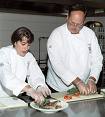.jpg) If Canadian cattle or chickens or pigs get sick, the public is told all about it. If Canadian people get sick, not so much.
If Canadian cattle or chickens or pigs get sick, the public is told all about it. If Canadian people get sick, not so much.
Like the salmonella in fruit salad outbreak from summer 2006, in which 41 culture-confirmed Salmonella serotype Oranienburg infections were diagnosed in persons in 10 northeastern U.S. states and one Canadian province. The U.S. Centers for Disease Control reports in a summary report today that the culprit was likely cantaloupe, served in fruit salad in health care facilities.
As Ben Chapman and I have written (left, not exactly as shown) it’s not the first time Canadians have been told about food safety problems in Canada by U.S. authorities. But you know all those folks at Health Canada and the Public Health Agency of Canada and that Canadian Food Inspection Agency are very important and busy people.
But there are a couple of areas where Canadians shine.
Hundreds can be sickened by food in Canada — like the 650 sickened in southern Ontario in fall 2005 by Salmonella in fresh sprouts — and no one will get sued. Sicken a Canadian’s pet, like with the melamine-contaminated pet food earlier this year, and Canadians are first in the lawsuit line.
But Canada’s real strength is beer.
Canadian Press reports today that Labatt breweries has solved the mystery of how some tainted bottles of Stella Artois were served to customers in Toronto and Kamloops, B.C.
Labatt corporate affairs vice president Neil Sweeney says the company created several displays for the beer and one of its suppliers filled the display bottles with concentrated alcohol.
Sweeney says, after speaking with thousands of bar owners across the country, Labatt discovered that some of the displays had been dismantled and the bottles placed behind the bars and eventually served to customers.
Labatt and the Canadian Food Inspection Agency warned consumers in July about cases of suspected tampering after ethanol was found in bottles of Stella Artois beer.
Several people drank some of the ethanol, although no one became ill.

Sweeney says settlements have been negotiated with some of the customers but he is not revealing how much compensation has been paid.
Oh, and at the wine and cheese festival at Disney in Orlando on the weekend, Amy and I went to the Canadian booth, where they were serving Labatt’s Blue.
I said to the Canadian behind the tap, "Blue is the best we can do?"
He directed me to another stand that at least had Moosehead.
Florida Today reports that Cocoa Beach could become the first beachside community in Brevard County, Florida, to allow restaurant patrons to bring their dogs to dinner (instead of leaving them outside in the rain, left).

.jpg) If Canadian cattle or chickens or pigs get sick, the public is told all about it. If
If Canadian cattle or chickens or pigs get sick, the public is told all about it. If 
 Almost two weeks ago
Almost two weeks ago  Does the chicken in this picture look cooked to you? Color is a lousy indicator of the doneness of chicken. The pictured chicken comes from
Does the chicken in this picture look cooked to you? Color is a lousy indicator of the doneness of chicken. The pictured chicken comes from  After defeating a ranked University of Texas team two years in a row — this time a 41-21 thumping last night in Austin — Kansas State is ranked 24 in the Associated Press poll, its first national ranking in years.
After defeating a ranked University of Texas team two years in a row — this time a 41-21 thumping last night in Austin — Kansas State is ranked 24 in the Associated Press poll, its first national ranking in years. I never liked the television series, Seinfeld.
I never liked the television series, Seinfeld.
 Gee’s Garden Bistro, 1145 N. Alvernon Way, Tuscon, Arizona, failed an unannounced restaurant inspection July 17. And a re-inspection July 27; and Aug. 8 and Aug. 21.
Gee’s Garden Bistro, 1145 N. Alvernon Way, Tuscon, Arizona, failed an unannounced restaurant inspection July 17. And a re-inspection July 27; and Aug. 8 and Aug. 21. Niagara Region politicians are calling on the province to make food safety preparation training mandatory for everyone in Ontario employed in the preparation and serving of food to the public.
Niagara Region politicians are calling on the province to make food safety preparation training mandatory for everyone in Ontario employed in the preparation and serving of food to the public..jpg) USA Today writers Elizabeth Weise and Julie Schmit report in a
USA Today writers Elizabeth Weise and Julie Schmit report in a .jpg) Continuing to expose iFSN’s hard work and dedication to developing a culture of food safety, I’m seated in a hotel conference room in Champaign, IL for the second day of the 8th Annual Food Safety Symposium sponsored by the
Continuing to expose iFSN’s hard work and dedication to developing a culture of food safety, I’m seated in a hotel conference room in Champaign, IL for the second day of the 8th Annual Food Safety Symposium sponsored by the  In one of the lamest food safety excuses ever tabled, defence lawyer Adrian Gundelach t
In one of the lamest food safety excuses ever tabled, defence lawyer Adrian Gundelach t